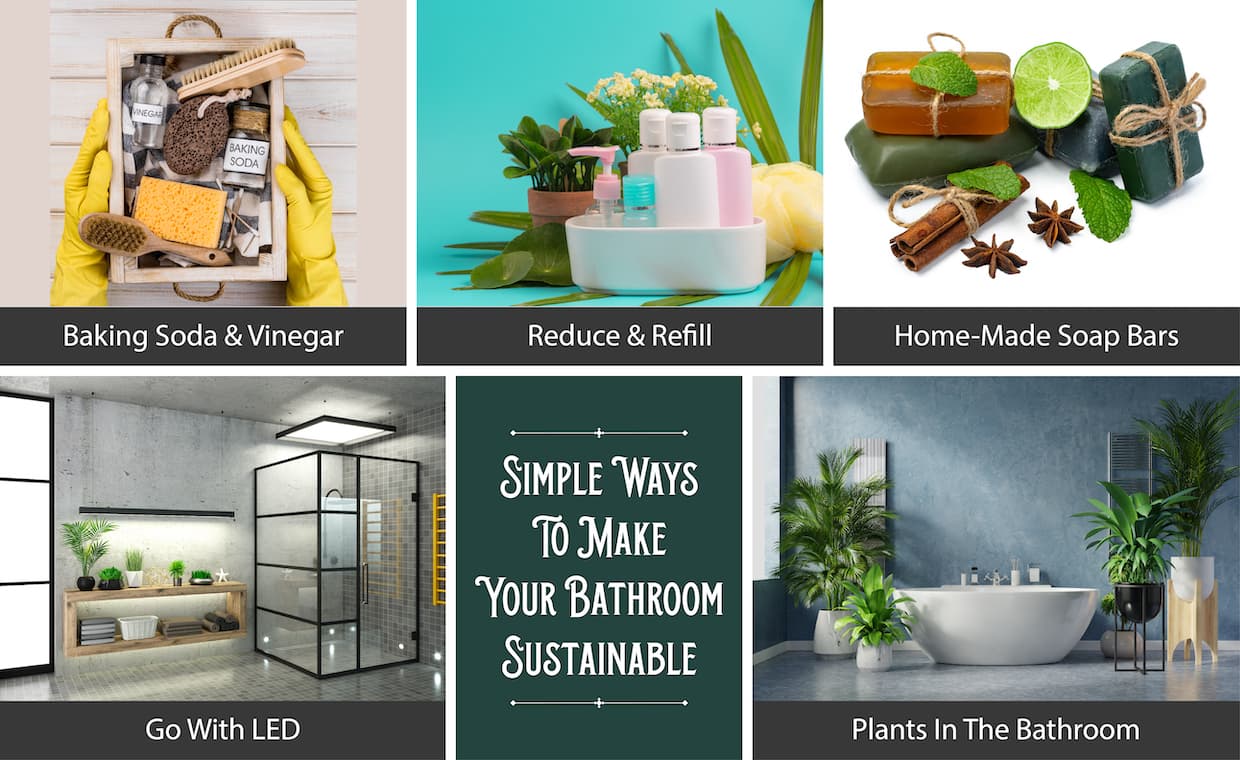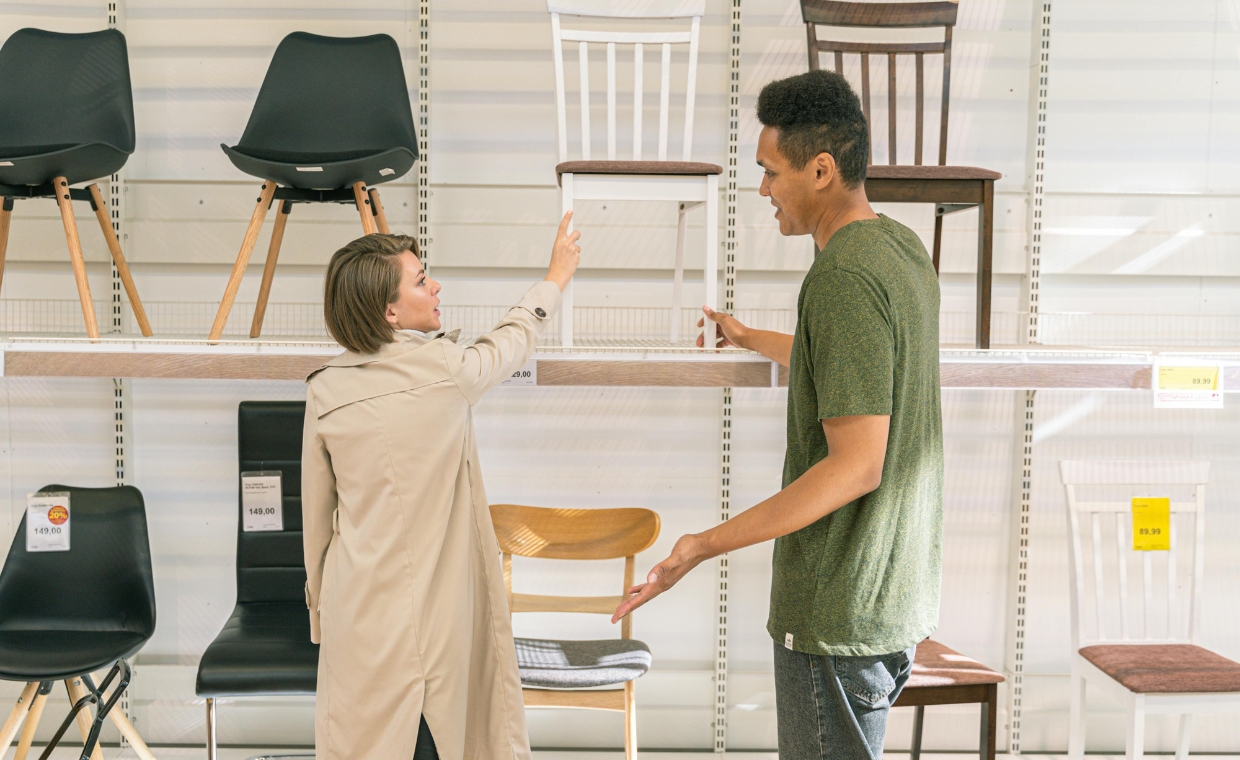
We do our best to fill our homes with eco-friendly things, but have we ever considered making our bathrooms greener? Well, that is one area of the house where we do not give the removal of items that affect the environment any concern. However, as the ‘green movement’ gains popularity, we must embrace sustainable lifestyles and pay attention to things that may be hazardous to the environment. In this blog, Gharpedia brings some simple ways to know how to make your bathroom eco-friendly.
How To Make Your Bathroom Eco-Friendly?
If you want to know how to make your bathroom eco-friendly, follow these simple and effective sustainable bathroom ideas.
- Eco-Friendly Bathroom Design and Décor
- Use Natural Materials
- Eco-Friendly Bathroom Appliances: Choose LED
- No Plastics for Sustainable Bathroom
- Spout And Shower Usage
- Use DIY Eco-Friendly Bathroom Products
- Go Organic for Sustainable Washroom
- Sustainable Bathroom Ideas: Reduce And Refill
- Sleek and Sustainable Idea: Add Green Touch
Let’s have a detailed look-
01. Eco-Friendly Bathroom Design and Décor

Designing and rebuilding the washrooms has its own environmental effects. It is crucial to building the bathrooms with the future in mind. This will help us avoid any future bathroom renovations. Making bathrooms more accessible, including a wet space, and using items that allow you to maintain your routine with few adjustments are all examples of efficient bathroom design. Using devices that conserve water, such as aerators, eco-friendly taps, washing machines, and dryers, can save on your water bills to some extent.
Here are some tips for designing a small bathroom according to your needs and comfort.
02. Use Natural Materials

We use a lot of chemicals to clean our bathrooms and wash our clothing, but we ignore how much damage they are doing to the environment. Using natural or homemade products can help us reduce our daily health risks and also ensure greater and longer-term well-being. For example, using non-toxic and low-VOC paints, varnishes, and coatings can help reduce the impact of pollutants that cause allergies and poor air quality. Using biodegradable versions of toiletries, chemical-free body cleaners are a good alternative.
03. Eco-Friendly Bathroom Appliances: Choose LED

LED is the best option for eco-friendly bathroom appliances. Washrooms, in particular, use a lot of light bulbs, each for a shower area, a toilet area, and near the mirror. As a result, the cumulative effect of switching to LED in the bathrooms will be more significant than in any other room in the house. Also, LEDs produce a range of lighting effects that can help you create the perfect look and feel.
04. No Plastics for Sustainable Bathroom

You can replace your plastic-containing bathroom accessories with sustainable ones. For example, vinyl and plastic shower curtains are bad for the environment. Replace your plastic curtains with shower screens. You may also opt for glass screens for your shower area. Another form of plastic used in bathrooms is containers. You can place decorative soap bases, hand soap containers, and shampoo containers that come in different colours and sizes and are made of environment-friendly materials like ceramic, clay, or glass.
05. Spout And Shower Usage

You can reduce water wastage by changing your daily habits, such as leaving the faucet running while washing your face or brushing your teeth. Turning off the tap while brushing your teeth can save you 8 gallons of water daily, and shaving can save up to 10 gallons. Fitting tap and shower aerators help mix air with water and reduce water wastage.
Swapping the bath for a shower is the most effective change you can make in your daily routine. Another way to save water is to look out for leaks and drips. In addition to costing house owners thousands a year, this also adds to the massive water waste effect on the environment.
06. Use DIY Eco-Friendly Bathroom Products

Find yourself green bathroom cleaners that avoid harmful chemicals going down the drain. Switching to DIY eco-friendly bathroom products is the most effective way to save your skin and the environment from harsh chemicals. Making ubtans (body scrubs and masks) for body cleaning, using baking soda and vinegar for cleaning the bathrooms, and placing eco-friendly wallpaper to avoid VOC paints are specific measures that can be taken to live a healthy life.
You may also use natural and recycled materials to make boxed storage for toiletries, hanging decor, floating shelves made of used wood, and old lights painted and reused near the mirror area as a decorative piece or for ambience lighting. DIY provides numerous opportunities to renovate the entire washroom and develop ideas that will lead to a healthy life while minimizing environmental impact.
07. Go Organic for Eco-Friendly Bathroom Accessories

Buying eco-friendly and organic products for daily usage requires little money or effort. Using eco-friendly bathroom accessories like bamboo screens, recycled toilet paper, organic cotton or bamboo towels, DIY linens, etc., can also help reduce the harmful effects on your health and the environment. In addition, plants help to purify the air, lowering stress levels and bringing a soothing element to the bathroom.
Using eco-friendly materials like concrete, steel, glass, and recycled wood can make your bathroom more sustainable. Upgrading your sink by designing it with materials like rubber, glass, porcelain, or steel can also be an alternative to add to the eco-friendly measures.
Here are some tips for choosing bathroom accessories, fixtures, wares etc.
08. Sustainable Bathroom Ideas: Reduce And Refill

Reducing and refilling are one of the best sustainable bathroom ideas. Refillable tactics are crucial to fight plastic pollution and achieving a circular economy. Reducing plastic and unhealthy products, reusing significant materials, and recycling whatever you use is the circular economy mantra to attain a sustainable washroom habit.
Start by replacing liquid soaps with bar soaps, bottles of shower gel, shampoo, and conditioner with bar soaps, shampoo, and natural homemade shower gels, and use reusable toilet paper. You can also use smart technologies available in the market, such as installing a save-a-flush cistern bag, which fills up the space in your tanks and reduces the wastage of water. You may use disposable razors, roll-ons, and antiperspirants instead of aerosols that diffuse small particles in the atmosphere.
09. Sleek and Sustainable Idea: Add Green Touch

Keeping the indoor air clean and fresh became a requirement after the pandemic hit the world. We may also keep our washrooms fresh and clean to avoid excessive moisture and suffocation. You can place air-purifying plants, moss floor mats, or green vertical walls to have low-maintenance plants that give a fresh touch to the bathrooms. You can place flower vases inside the bathrooms and change them daily, keeping the air clean and fragrant. Replacing PVC bath mats with anti-bacterial eco-friendly bath mats can contribute to a healthier lifestyle.
Following these sustainable bathroom ideas should help you understand how to make your bathroom eco-friendly.
Before leaving this page, don’t forget to look at every bathroom’s basic facilities for wellness and hygiene.
Facilities that Every Bathroom Needs for Wellness & Hygiene!
Author Bio
Neha Bhasin – Neha Bhasin is the Principal architect of Pramana Design Studio, a leading design consultancy firm with a strong design instinct in projects that range from recycling land and master planning to the design of spaces, hospitality, houses, and commercial buildings, thereby engaging diverse issues, multiple constituencies and varying scales from interior design and architecture to urban design and planning. She has a degree in Bachelors in Architecture from Apeejay Institute of Technology, SAP, Greater Noida with a Certification in Housing Planning and Policies focused on Housing and Human Environments from the Indian Institute of Technology, Roorkee. Neha has a well-demonstrated history of 7 years, and besides being a prodigious reader, she has assisted many professionals in editing books from an architect’s perspective.
































